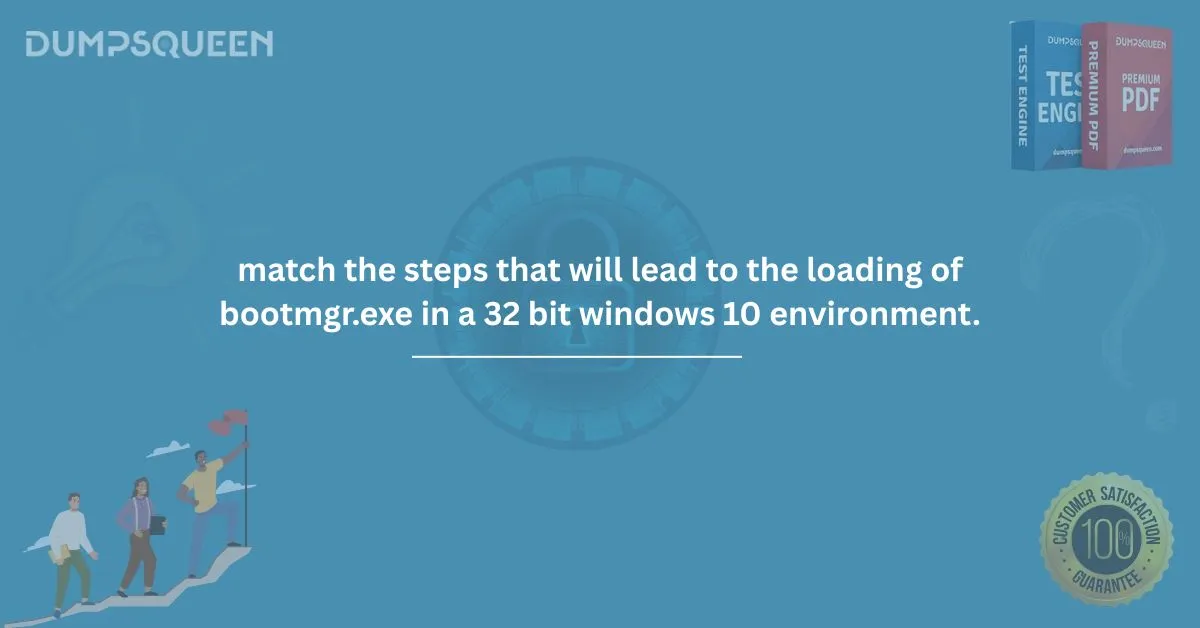Introduction
In a 32-bit Windows 10 environment, the boot process plays a crucial role in initializing the system and preparing it for use. One of the essential components of this process is bootmgr.exe, the Windows Boot Manager, which is responsible for loading the operating system. Understanding the sequence of steps leading to its execution is fundamental for IT professionals, system administrators, and certification aspirants. This article explores the detailed process that occurs from powering on a machine to the loading of bootmgr.exe, offering insights valuable for anyone looking to enhance their knowledge in Windows system operations.
Powering On and POST Execution
The boot process begins when the user presses the power button on their computer. At this point, the system's firmware executes the Power-On Self-Test (POST). POST is responsible for checking hardware components such as the RAM, CPU, storage drives, and peripheral devices. If no hardware failures are detected, the system proceeds to the next stage of the boot process.
Firmware Execution and Boot Order Selection
After a successful POST, the Basic Input/Output System (BIOS) or the Unified Extensible Firmware Interface (UEFI) takes control. In legacy BIOS-based systems, the Master Boot Record (MBR) is used to identify bootable devices. Conversely, in UEFI-based systems, the GUID Partition Table (GPT) is used. The firmware checks the boot order settings configured in the system BIOS/UEFI to determine the appropriate boot device, which could be a hard drive, SSD, USB, or network device.
Locating the Boot Code in the MBR
For an MBR-based boot process, the firmware reads the first sector (512 bytes) of the bootable storage device. This sector contains the Boot Code, which is responsible for identifying and loading the boot manager. The boot sector code searches for bootmgr.exe and passes execution control to it.
Bootmgr Execution and Boot Configuration Data (BCD) Parsing
Once the Boot Code executes bootmgr.exe, the Boot Manager begins parsing the Boot Configuration Data (BCD) file. The BCD is a firmware-independent database that contains essential boot-related settings, including available operating systems, boot options, and other system configurations. The Boot Manager loads the relevant operating system entry and prepares it for execution.
Kernel Loading and Initial Execution
After reading the BCD, bootmgr.exe proceeds with loading the Windows kernel (ntoskrnl.exe). This involves initializing critical system drivers, memory management routines, and hardware abstraction layers. The kernel then takes control and begins executing system-level tasks required for user-mode operations.
System Initialization and User Login
Once the Windows kernel is loaded, the system continues with the initialization of services, drivers, and the Windows session manager (smss.exe). The login screen is presented, allowing the user to authenticate and start their session. At this stage, the boot process is complete, and the operating system is fully functional.
Conclusion
Understanding the boot process and the steps leading to the execution of bootmgr.exe is essential for IT professionals working with Windows environments. From POST to firmware execution, Boot Manager loading, and kernel initialization, each step plays a vital role in ensuring a smooth system startup. By mastering these concepts, individuals preparing for certification exams and troubleshooting system boot issues can enhance their expertise in Windows operating systems.
Free Sample Questions
1. What is the primary function of bootmgr.exe in a 32-bit Windows 10 environment?
-
A) To execute POST diagnostics
-
B) To manage system memory
-
C) To load and manage the boot process
-
D) To configure BIOS settings
Answer: C) To load and manage the boot process
2. Which component is responsible for executing the Power-On Self-Test (POST)?
-
A) Windows Kernel
-
B) Bootmgr
-
C) BIOS/UEFI firmware
-
D) Boot Configuration Data (BCD)
Answer: C) BIOS/UEFI firmware
3. Where is the Boot Configuration Data (BCD) stored?
-
A) In the MBR sector of the disk
-
B) In the Windows Registry
-
C) In a separate partition on the boot disk
-
D) In the system memory
Answer: C) In a separate partition on the boot disk
4. What file does bootmgr.exe load after parsing the BCD?
-
A)
winload.exe -
B)
ntoskrnl.exe -
C)
smss.exe -
D)
cmd.exe
Answer: A) winload.exe



